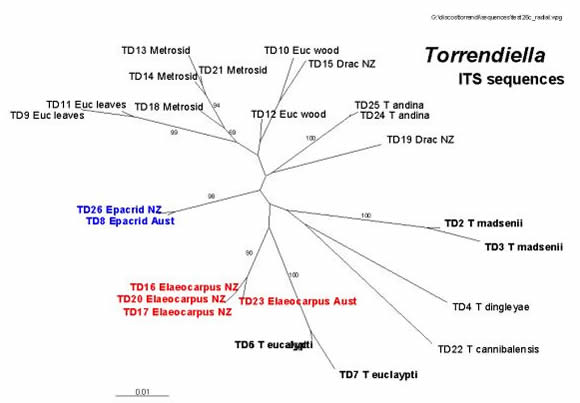Torrendiella in Australia and NZ

Torrendiella madsenii. Image P Johnston
Information presented in this page is based on Johnston, P.R.; Gamundí, I.J. 2000: Torrendiella (Ascomycota, Helotiales) on Nothofagus. New Zealand Journal of Botany 38<: 493 – 513, together with additional unpublished data.
Torrendiella is a genus of inoperculate discomycetes, characterised macroscopically by the presence of setae on the receptacle.
Although all Torrendiella species produce their fruiting bodies on dead plant tissue, at least two species have been isolated as endophytes from living leaves. Given the high degree of host-specialisation within the genus, it is likely that most species have a similar biology.
Morphological, cultural, and molecular evidence shows there are a large number of undescribed, host-specialised, leaf-inhabiting Torrendiella species in Australia and New Zealand. Originally described from T. ciliata, a species apprently widespread in Europe, the genus is particularly diverse in the Southern Hemisphere. Brian Spooner, in his classic monograph of Australasian inoperculate discomycetes, accepted three Torrendiella species from Australasia. These included 2 wood-inhabiting species, T. madsenii and T. clelandii, while all the leaf-inhabiting collections were placed in T. eucalypti. The type specimen of T. eucalypti is on Acacia leaves, and we agree with Beaton & Weste (1977) that this species is in fact restricted to Acacia.
Our paper described species from Nothofagus, but there are several other as yet undescribed species on other hosts in both Australia and New Zealand (see Table below). Other species no doubt await discovery.
| Undescribed Torrendiella species from Australia and New Zealand are found on the following hosts | |
| Australia | New Zealand |
| Epacridaceae leaves | Epacridaceae leaves (several species) |
| Elaeocarpaceae leaves | Elaeocarpaceae leaves |
| Eucalyptus leaves | Coriaria wood |
| Acmena smithii leaves | Metrosideros leaves (more than 1 species) |
| Proteaceae leaves | Leptospermum wood |
| Lophomyrtus bullata leaves | |
In several cases, such as one of the Epacridaceae-inhabiting species and the Elaeocarpaceae-inhabiting species, the same species occurs in both Australia and New Zealand. The tree below, based on ITS rDNA sequences, shows this for one of the Epacridaceae-inhabiting species (blue on the tree) and the Elaeocarpaceae-inhabiting species (red on the tree).

Ongoing molecular studies on Torrrendiella are addressing several questions:
- Do DNA sequence data support the morphology data in suggesting there are a range of host-specialised, leaf-inhabiting species in Autralasia, distinct from the Acacia-specialised T. eucalypti?
- Is Torrendiella a member of the Rutstroemiaceae?
- Does the occurrence of several Torrendiella species on a single host represent divergence following a single adaptation to that host? or does it represent multiple adaptations to that host?
